弗洛伊德与精神分析理论_英文
- 格式:ppt
- 大小:955.50 KB
- 文档页数:27
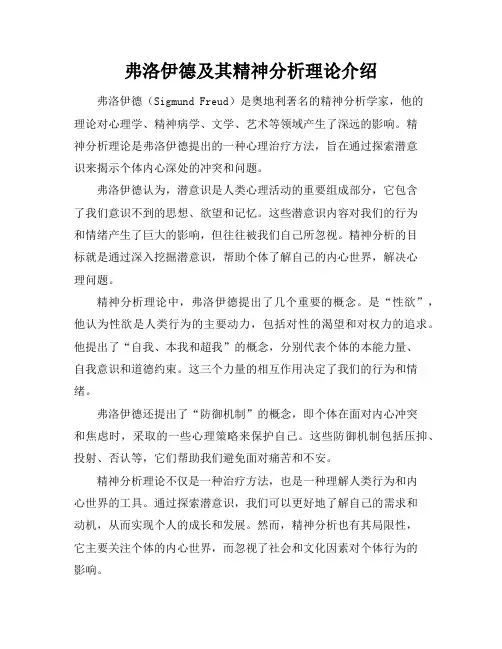
弗洛伊德及其精神分析理论介绍弗洛伊德(Sigmund Freud)是奥地利著名的精神分析学家,他的理论对心理学、精神病学、文学、艺术等领域产生了深远的影响。
精神分析理论是弗洛伊德提出的一种心理治疗方法,旨在通过探索潜意识来揭示个体内心深处的冲突和问题。
弗洛伊德认为,潜意识是人类心理活动的重要组成部分,它包含了我们意识不到的思想、欲望和记忆。
这些潜意识内容对我们的行为和情绪产生了巨大的影响,但往往被我们自己所忽视。
精神分析的目标就是通过深入挖掘潜意识,帮助个体了解自己的内心世界,解决心理问题。
精神分析理论中,弗洛伊德提出了几个重要的概念。
是“性欲”,他认为性欲是人类行为的主要动力,包括对性的渴望和对权力的追求。
他提出了“自我、本我和超我”的概念,分别代表个体的本能力量、自我意识和道德约束。
这三个力量的相互作用决定了我们的行为和情绪。
弗洛伊德还提出了“防御机制”的概念,即个体在面对内心冲突和焦虑时,采取的一些心理策略来保护自己。
这些防御机制包括压抑、投射、否认等,它们帮助我们避免面对痛苦和不安。
精神分析理论不仅是一种治疗方法,也是一种理解人类行为和内心世界的工具。
通过探索潜意识,我们可以更好地了解自己的需求和动机,从而实现个人的成长和发展。
然而,精神分析也有其局限性,它主要关注个体的内心世界,而忽视了社会和文化因素对个体行为的影响。
弗洛伊德及其精神分析理论为心理学领域带来了重要的突破,帮助我们更好地理解人类的行为和内心世界。
然而,我们也要保持批判性思维,不断探索和发展新的理论和方法,以更好地解决个体的心理问题。
弗洛伊德及其精神分析理论介绍弗洛伊德(Sigmund Freud)是奥地利著名的精神分析学家,他的理论对心理学、精神病学、文学、艺术等领域产生了深远的影响。
精神分析理论是弗洛伊德提出的一种心理治疗方法,旨在通过探索潜意识来揭示个体内心深处的冲突和问题。
精神分析理论认为,潜意识是人类心理活动的重要组成部分,它包含了我们意识不到的思想、欲望和记忆。

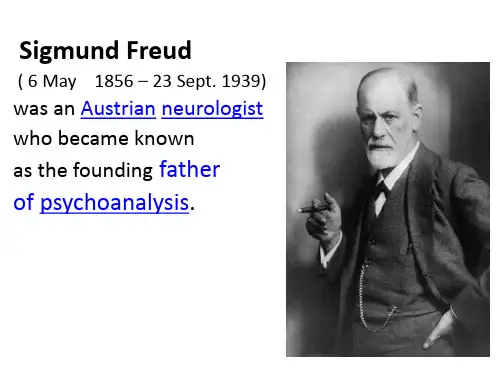
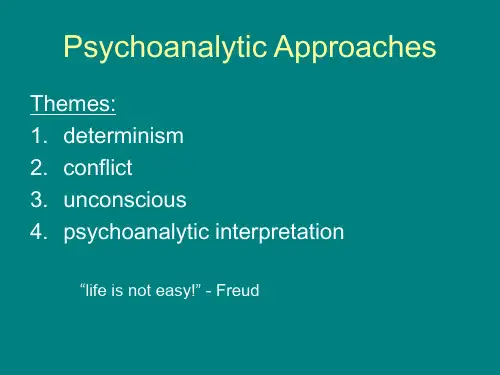

西格蒙德·弗洛伊德(Sigmund Freud,1856~1939),奥地利犹太心理学家、精神病医师。
精神分析学派创始人。
他把人的心理分为意识、前意识和无意识(潜意识、下意识)。
意识(conscious)即自觉,凡是自己能察觉的心理活动是意识,它属于人的心理结构的表层,它感知着外界现实环境和刺激,用语言来反映和概括事物的理性内容。
前意识(preconscious)是调节意识和无意识的中介机制。
前意识是潜意识的一部分,是一种可以被回忆起来的、能被召唤到清醒意识中的部分,它的作用更体现在阻止潜意识进入意识,它起着“检查”作用,绝大部分充满本能冲动的潜意识被它控制,不可能变成前意识,更不可能进入意识。
潜意识(又称无意识,英文subconscious,又译为下意识),则是在意识和前意识之下受到压抑的没有被意识到的心理活动,代表着人类更深层、更隐秘、更原始、更根本的心理能量。
认为存在于无意识中的性本能(生殖本能)是人的心理的基本动力,是支配个人命运、决定社会发展的力量;并把人格区分为自我、本我和超我三个部分。
1、本我:位于人格结构的最低层,是由先天的本能、欲望所组成的能量系统,包括各种生理需要。
本我是无意识,非理性的。
遵循快乐原则。
2、自我:位于人格结构的中间层,从本我中分化出来的,其作用是调节本我和超我的矛盾。
遵循现实原则。
3、超我:位于人格结构的最高层。
是道德化的自我。
它的作用是:抑制本我的冲动;对自我进行监控;追求完善的境界。
遵循道德原则。
其学说被西方哲学和人文学科各领域吸收和运用。
主要著作有《梦的解析》(1900)、《日常生活的精神病理学》(1904)、《精神分析引论》(1910)、《图腾与禁忌》(1913)、《精神分析引论新编》(1933)等。

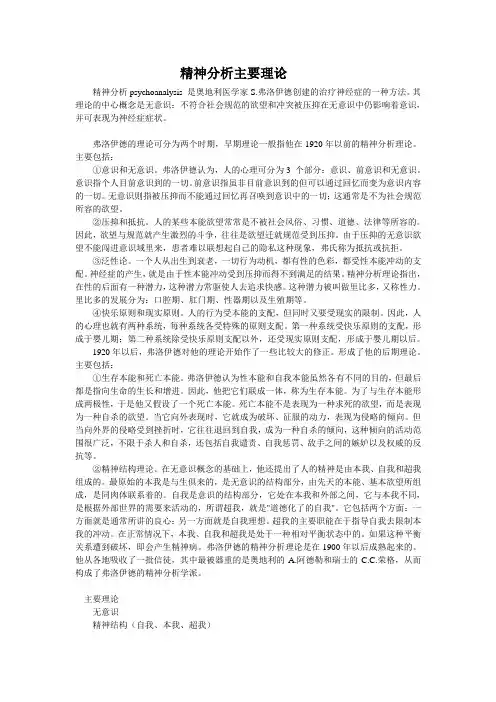
精神分析主要理论精神分析psychoanalysis 是奥地利医学家S.弗洛伊德创建的治疗神经症的一种方法。
其理论的中心概念是无意识;不符合社会规范的欲望和冲突被压抑在无意识中仍影响着意识,并可表现为神经症症状。
弗洛伊德的理论可分为两个时期,早期理论一般指他在1920年以前的精神分析理论。
主要包括:①意识和无意识。
弗洛伊德认为,人的心理可分为3 个部分:意识、前意识和无意识。
意识指个人目前意识到的一切。
前意识指虽非目前意识到的但可以通过回忆而变为意识内容的一切。
无意识则指被压抑而不能通过回忆再召唤到意识中的一切;这通常是不为社会规范所容的欲望。
②压抑和抵抗。
人的某些本能欲望常常是不被社会风俗、习惯、道德、法律等所容的。
因此,欲望与规范就产生激烈的斗争,往往是欲望迁就规范受到压抑。
由于压抑的无意识欲望不能闯进意识域里来,患者难以联想起自己的隐私这种现象,弗氏称为抵抗或抗拒。
③泛性论。
一个人从出生到衰老,一切行为动机,都有性的色彩,都受性本能冲动的支配。
神经症的产生,就是由于性本能冲动受到压抑而得不到满足的结果。
精神分析理论指出,在性的后面有一种潜力,这种潜力常驱使人去追求快感。
这种潜力被叫做里比多,又称性力。
里比多的发展分为:口腔期、肛门期、性器期以及生殖期等。
④快乐原则和现实原则。
人的行为受本能的支配,但同时又要受现实的限制。
因此,人的心理也就有两种系统,每种系统各受特殊的原则支配。
第一种系统受快乐原则的支配,形成于婴儿期;第二种系统除受快乐原则支配以外,还受现实原则支配,形成于婴儿期以后。
1920年以后,弗洛伊德对他的理论开始作了一些比较大的修正。
形成了他的后期理论。
主要包括:①生存本能和死亡本能。
弗洛伊德认为性本能和自我本能虽然各有不同的目的,但最后都是指向生命的生长和增进。
因此,他把它们联成一体,称为生存本能。
为了与生存本能形成两极性,于是他又假设了一个死亡本能。
死亡本能不是表现为一种求死的欲望,而是表现为一种自杀的欲望。

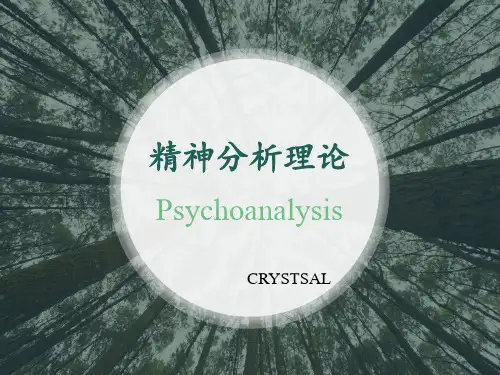
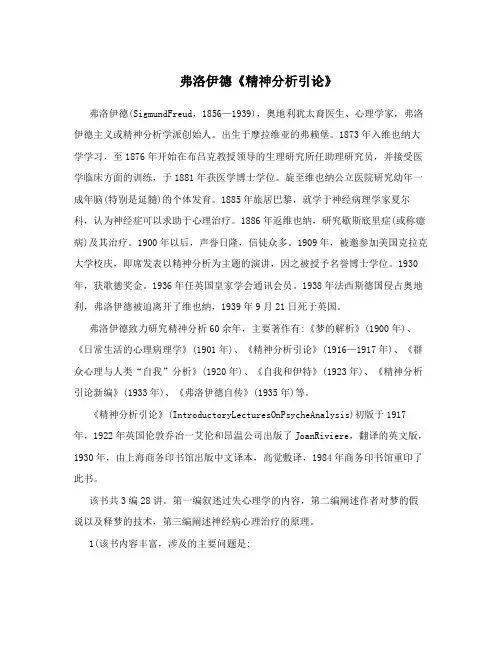
弗洛伊德《精神分析引论》弗洛伊德(SigmundFreud,1856—1939),奥地利犹太裔医生、心理学家,弗洛伊德主义或精神分析学派创始人。
出生于摩拉维亚的弗赖堡。
1873年入维也纳大学学习,至1876年开始在布吕克教授领导的生理研究所任助理研究员,并接受医学临床方面的训练,于1881年获医学博士学位。
旋至维也纳公立医院研究幼年一成年脑(特别是延髓)的个体发育。
1885年旅居巴黎,就学于神经病理学家夏尔科,认为神经症可以求助于心理治疗。
1886年返维也纳,研究歇斯底里症(或称癔病)及其治疗。
1900年以后,声誉日隆,信徒众多。
1909年,被邀参加美国克拉克大学校庆,即席发表以精神分析为主题的演讲,因之被授予名誉博士学位。
1930年,获歌德奖金。
1936年任英国皇家学会通讯会员。
1938年法西斯德国侵占奥地利,弗洛伊德被迫离开了维也纳,1939年9月21日死于英国。
弗洛伊德致力研究精神分析60余年,主要著作有:《梦的解析》(1900年)、《日常生活的心理病理学》(1901年)、《精神分析引论》(1916—1917年)、《群众心理与人类“自我”分析》(1920年)、《自我和伊特》(1923年)、《精神分析引论新编》(1933年)、《弗洛伊德自传》(1935年)等。
《精神分析引论》(IntroductoryLecturesOnPsycheAnalysis)初版于1917年,1922年英国伦敦乔冶一艾伦和昂温公司出版了JoanRiviere,翻译的英文版,1930年,由上海商务印书馆出版中文译本,高觉敷译,1984年商务印书馆重印了此书。
该书共3编28讲。
第一编叙述过失心理学的内容,第二编阐述作者对梦的假说以及释梦的技术,第三编阐述神经病心理治疗的原理。
1(该书内容丰富,涉及的主要问题是:关于意识与潜意识的关系问题。
弗洛伊德认为人的一切行动都决定于潜意识的欲望,但他也说:“但这决不意味着,对我们来说,意识的属性已经失去了它的重要性。
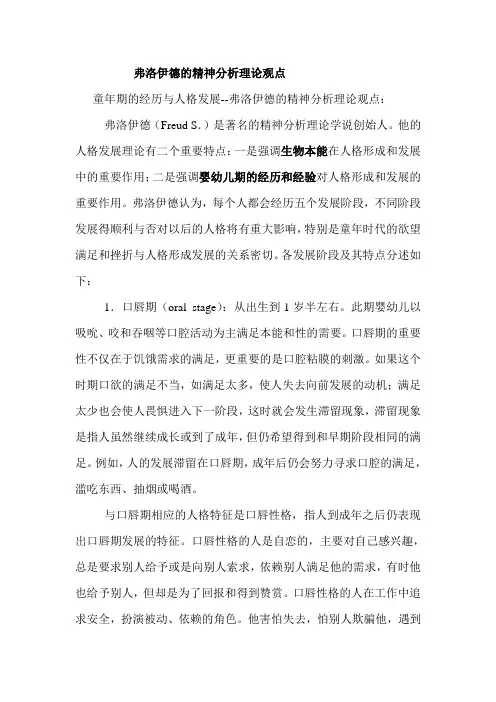
弗洛伊德的精神分析理论观点童年期的经历与人格发展--弗洛伊德的精神分析理论观点:弗洛伊德(Freud S.)是著名的精神分析理论学说创始人。
他的人格发展理论有二个重要特点:一是强调生物本能在人格形成和发展中的重要作用;二是强调婴幼儿期的经历和经验对人格形成和发展的重要作用。
弗洛伊德认为,每个人都会经历五个发展阶段,不同阶段发展得顺利与否对以后的人格将有重大影响,特别是童年时代的欲望满足和挫折与人格形成发展的关系密切。
各发展阶段及其特点分述如下:1.口唇期(oral stage):从出生到1岁半左右。
此期婴幼儿以吸吮、咬和吞咽等口腔活动为主满足本能和性的需要。
口唇期的重要性不仅在于饥饿需求的满足,更重要的是口腔粘膜的刺激。
如果这个时期口欲的满足不当,如满足太多,使人失去向前发展的动机;满足太少也会使人畏惧进入下一阶段,这时就会发生滞留现象,滞留现象是指人虽然继续成长或到了成年,但仍希望得到和早期阶段相同的满足。
例如,人的发展滞留在口唇期,成年后仍会努力寻求口腔的满足,滥吃东西、抽烟或喝酒。
与口唇期相应的人格特征是口唇性格,指人到成年之后仍表现出口唇期发展的特征。
口唇性格的人是自恋的,主要对自己感兴趣,总是要求别人给予或是向别人索求,依赖别人满足他的需求,有时他也给予别人,但却是为了回报和得到赞赏。
口唇性格的人在工作中追求安全,扮演被动、依赖的角色。
他害怕失去,怕别人欺骗他,遇到挫折时易怒或想不开。
Coldman-Eisler的研究为口唇期的满足与否对人格发展的影响提供了依据。
在这个研究中,根据断奶迟早不同将受试者分成二组:一组是早期断奶者(5个月内),称为不满足组;另一组较晚才断奶(5个月以上),称为满足组。
比较二组受试者在人格测验的结果发现差异显著:不满足组在悲观、被动、退缩因素方面的评分较高;满足组则在乐观、外向、社会性因素方面的评分较高。
2.肛门期(anal stage):大约从1~3岁左右。
PsychoanalysisPsychoanalysis (or Freudian psychology) is a body of ideas developed by Austrian physician Sigmund Freud and continued by others. It is primarily devoted to the study of human psychological functioning and behavior, although it can also be applied to societies. Psychoanalysis has three applications:1. a method of investigation of the mind and the way one thinks;2. a systematized set of theories about human behavior;3. a method of treatment of psychological or emotional illness.[1]Under the broad umbrella of what is psychoanalysis, there are at least 22 theoretical orientations regarding the underlying theory of understanding of human mentation and human development. The various approaches in treatment called "psychoanalytic" vary as much as the theories do. The term also refers to a method of studying child development.Freudian psychoanalysis refers to a specific type of treatment in which the "analysand" (analytic patient) verbalizes thoughts, including free associations, fantasies, and dreams, from which the analyst formulates the unconscious conflicts causing the patient's symptoms and character problems, and interprets them for the patient to create insight for resolution of the problems. The specifics of the analyst's interventions typically include confronting and clarifying the patient's pathological defenses, wishes and guilt. Through the analysis of conflicts, including those contributing to resistance and those involving transference onto the analyst of distorted reactions, psychoanalytic treatment can clarify how patients unconsciously are their own worst enemies: how unconscious, symbolic reactions that have been stimulated by experience are causing symptoms.Contents[hide]∙ 1 Historyo 1.1 1890so 1.2 1900–1940so 1.3 1940s-2000s∙ 2 Theorieso 2.1 Topographic theoryo 2.2 Structural theoryo 2.3 Ego psychologyo 2.4 Conflict theoryo 2.5 Object relations theoryo 2.6 Self psychologyo 2.7 Jacques Lacan/Lacanian psychoanalysiso 2.8 Interpersonal psychoanalysiso 2.9 Culturalist psychoanalystso 2.10 Relational psychoanalysiso 2.11 Interpersonal-Relational psychoanalysiso 2.12 Intersubjective psychoanalysiso 2.13 Modern psychoanalysiso 2.14 Micropsychoanalysis∙ 3 Psychopathology (mental disturbances)o 3.1 Adult patientso 3.2 Childhood origins∙ 4 Treatmento 4.1 Techniques4.1.1 Variations in techniqueo 4.2 Group therapy and play therapyo 4.3 Cultural variationso 4.4 Cost and length of treatment∙ 5 Training and researcho 5.1 Psychoanalysis in Britaino 5.2 Research∙ 6 Criticismo 6.1 Charges of fascismo 6.2 Scientific criticismo 6.3 Theoretical criticism∙7 References∙8 Literature∙9 Critiques of psychoanalysis∙10 Responses to critiques∙11 External links[edit] History[edit] 1890sThe idea of psychoanalysis was developed in Vienna in the 1890s by Sigmund Freud, a neurologist interested in finding an effective treatment for patients with neurotic or hysterical symptoms. Freud had become aware of the existence of mental processes that were not conscious as a result of hisneurological consulting job at the Children's Hospital, where he noticed that many aphasic children had no organic cause for their symptoms. He wrote a monograph about this subject.[2] In the late 1880s, Freud obtained a grant to study with Jean-Martin Charcot, the famed neurologist and syphilologist, at the Salpêtrière in Paris. Charcot had become interested in patients who had symptoms that mimicked general paresis. Freud's first theory to explain hysterical symptoms was the so-called "seduction theory". Since his patients under treatment with this new method "remembered" incidents of having been sexually seduced in childhood, Freud believed that they had actually been abused only to later repress those memories. This led to his publication with Dr. Breuer in 1893 of case reports of the treatment of hysteria.[3] This first theory became untenable as an explanation of all incidents of hysteria. As a result of his work with his patients, Freud learned that the majority complained of sexual problems, especially coitus interruptus as birth control. He suspected their problems stemmed from cultural restrictions on sexual expression and that their sexual wishes and fantasies had been repressed. Between this discovery of the unexpressed sexual desires and the relief of the symptoms by abreaction, Freud began to theorize that the unconscious mind had determining effects on hysterical symptoms.His first comprehensive attempt at an explanatory theory was the then unpublished Project for a Scientific Psychology in 1895.[4]In this work Freud attempted to develop a neurophysiologic theory based on transfer of energy by the neurons in the brain in order to explain unconscious mechanisms. He abandoned the project when he came to realize that there was a complicated psychological process involved over and above neuronal activity. By 1900, Freud had discovered that dreams had symbolic significance, and generally were specific to the dreamer. Freud formulated his second psychological theory— which postulates that the unconscious has or is a "primary process" consisting of symbolic and condensed thoughts, and a "secondary process" of logical, conscious thoughts. This theory was published in his 1900 opus magnum, The Interpretation of Dreams.[5] Chapter VII was a re-working of the earlier "Project" and Freud outlined his "Topographic Theory." In this theory, which was mostly later supplanted by the Structural Theory, unacceptable sexual wishes were repressed into the "System Unconscious," unconscious due to society's condemnation of premarital sexual activity, and this repression created anxiety. Freud also discovered what most of us take for granted today: that dreams were symbolic and specific to the dreamer. Often, dreams give clues to unconscious conflicts, and for this reason, Freud referred to dreams as the "royal road to the Unconscious."[edit] 1900–1940sThis "topographic theory" is still popular in much of Europe, although it has been superseded in much of North America.[6] In 1905, Freud published ThreeEssays on the Theory of Sexuality[7]in which he laid out his discovery of so-called psychosexual phases: oral (ages 0–2), anal (2-4), phallic-oedipal (today called 1st genital) (3-6), latency (6-puberty), and mature genital (puberty-onward). His early formulation included the idea that because of societal restrictions, sexual wishes were repressed into an unconscious state, and that the energy of these unconscious wishes could be turned into anxiety or physical symptoms. Therefore the early treatment techniques, including hypnotism and abreaction, were designed to make the unconscious conscious in order to relieve the pressure and the apparently resulting symptoms.In On Narcissism(1915)[8]Freud turned his attention to the subject of narcissism. Still utilizing an energic system, Freud conceptualized the question of energy directed at the self versus energy directed at others, called cathexis. By 1917, In "Mourning and Melancholia," he suggested that certain depressions were caused by turning guilt-ridden anger on the self.[9] In 1919 in "A Child is Being Beaten" he began to address the problems of self-destructive behavior (moral masochism) and frank sexual masochism.[10]Based on his experience with depressed and self-destructive patients, and pondering the carnage of WWI, Freud became dissatisfied with considering only oral and sexual motivations for behavior. By 1920, Freud addressed the power of identification (with the leader and with other members) in groups as a motivation for behavior (Group Psychology and Analysis of the Ego).[11] In that same year (1920) Freud suggested his "dual drive" theory of sexuality and aggression in Beyond the Pleasure Principle, to try to begin to explain human destructiveness.[12]In 1923, he presented his new "structural theory" of an id, ego, and superego in a book entitled, The Ego and the Id.[13] Therein, he revised the whole theory of mental functioning, now considering that repression was only one of many defense mechanisms, and that it occurred to reduce anxiety. Note that repression, for Freud, is both a cause of anxiety and a response to anxiety. In 1926, in Inhibitions, Symptoms and Anxiety, Freud laid out how intrapsychic conflict among drive and superego (wishes and guilt) caused anxiety, and how that anxiety could lead to an inhibition of mental functions, such as intellect and speech.[14]. Inhibitions, Symptoms and Anxiety was written in response to Otto Rank, who, in 1924, published Das Trauma der Geburt (translated into English in 1929 as The Trauma of Birth), exploring how art, myth, religion, philosophy and therapy were illuminated by separation anxiety in the "phase befo re the development of the Oedipus complex" (p. 216). But there was no such phase in Freud’s theories. The Oedipus complex, Freud explained tirelessly, was the nucleus of the neurosis and the foundational source of all art, myth, religion, philosophy, therapy—indeed of all human culture and civilization. It was the first time that anyone in the inner circle had dared to suggest that the Oedipus complex might not be the only factor contributing to intrapsychic developmentBy 1936, the "Principle of Multiple Function" was clarified by Robert Waelder.[15]He widened the formulation that psychological symptoms were caused by and relieved conflict simultaneously. Moreover, symptoms (such as phobias and compulsions) each represented elements of some drive wish (sexual and/or aggressive), superego (guilt), anxiety, reality, and defenses. Also in 1936, Anna Freud, Sigmund's famous daughter, published her seminal book, The Ego and the Mechanisms of Defense, outlining numerous ways the mind could shut upsetting things out of consciousness.[16][edit] 1940s-2000sFollowing the death of Freud, a new group of psychoanalysts began to explore the function of the ego. Led by Hartmann, Kris, Rappaport and Lowenstein, the group built upon understandings of the synthetic function of the ego as a mediator in psychic functioning. Hartmann in particular distinguished between autonomous ego functions (such as memory and intellect which could be secondarily affected by conflict) and synthetic functions which were a result of compromise formation. These "Ego Psychologists" of the '50s paved a way to focus analytic work by attending to the defenses (mediated by the ego) before exploring the deeper roots to the unconscious conflicts. In addition there was burgeoning interest in child psychoanalysis. Although criticized since its inception, psychoanalysis has been used as a research tool into childhood development,[17] and has is still used to treat certain mental disturbances.[18] In the 1960s, Freud's early thoughts on the childhood development of female sexuality were challenged; this challenge led to the development of a variety of understandings of female sexual development, many of which modified the timing and normality of several of Freud's theories (which had been gleaned from the treatment of women with mental disturbances). Several researchers[19] followed Karen Horney's studies of societal pressures that influence the development of women. Most contemporary North American psychoanalysts employ theories that, while based on those of Sigmund Freud, include many modifications of theory and practice developed since his death in 1939.In the 2000s there are approximately 35 training institutes for psychoanalysis in the United States accredited by the American Psychoanalytic Association [4][20] which is a component organization of the International Psychoanalytical Association, and there are over 3,000 graduated psychoanalysts practicing in the United States. The International Psychoanalytical Association accredits psychoanalytic training centers throughout the rest of the world, including countries such as Serbia, France, Germany, Austria, Italy, Switzerland, and many others, as well as about six institutes directly in the U.S. Freud published a paper entitled The History of the Psychoanalytic Movement in 1914, German original being first published in the Jahrbuch der Psychoanalyse.[21][edit] TheoriesThe predominant psychoanalytic theories can be grouped into several theoretical "schools." Although these theoretical "schools" differ, most of them continue to stress the strong influence of unconscious elements affecting people's mental lives. There has also been considerable work done on consolidating elements of conflicting theory (cf. the work of Theodore Dorpat, B. Killingmo, and S. Akhtar). As in all fields of healthcare, there are some persistent conflicts regarding specific causes of some syndromes, and disputes regarding the best treatment techniques. In the 2000s, psychoanalytic ideas are embedded in Western culture, especially in fields such as childcare, education, literary criticism, cultural studies, and mental health, particularly psychotherapy. Though there is a mainstream of evolved analytic ideas, there are groups who follow the precepts of one or more of the later theoreticians. Psychoanalytic ideas also play roles in some types of literary analysis such as Archetypal literary criticism.[edit] Topographic theoryTopographic theory was first described by Freud in "The Interpretation of Dreams" (1900)[22][23]The theory posits that the mental apparatus can be divided in to the systems Conscious, Pre-conscious and Unconscious. These systems are not anatomical structures of the brain but, rather, mental processes. Although Freud retained this theory throughout his life he largely replaced it with the Structural theory. The Topographic theory remains as one of the metapsychological points of view for describing how the mind functions in classical psychoanalytic theory.[edit] Structural theoryStructural theory divides the psyche into the id, the ego, and the super-ego. The id is present at birth as the repository of basic instincts, which Freud called "Triebe" ("drives"): unorganised and unconscious, it operates merely on the 'pleasure principle', without realism or foresight. The ego develops slowly and gradually, being concerned with mediating between the urgings of the id and the realities of the external world; it thus operates on the 'reality principle'. The super-ego is held to be the part of the ego in which self-observation, self-criticism and other reflective and judgemental faculties develop. The ego and the super-ego are both partly conscious and partly unconscious.[edit] Ego psychologyEgo psychology was initially suggested by Freud in Inhibitions, Symptoms and Anxiety (1926). The theory was refined by Hartmann, Loewenstein, and Kris ina series of papers and books from 1939 through the late 1960s. Leo Bellak was a later contributor. This series of constructs, paralleling some of the later developments of cognitive theory, includes the notions of autonomous ego functions: mental functions not dependent, at least in origin, on intrapsychic conflict. Such functions include: sensory perception, motor control, symbolic thought, logical thought, speech, abstraction, integration (synthesis), orientation, concentration, judgment about danger, reality testing, adaptive ability, executive decision-making, hygiene, and self-preservation. Freud noted that inhibition is one method that the mind may utilize to interfere with any of these functions in order to avoid painful emotions. Hartmann (1950s) pointed out that there may be delays or deficits in such functions.Frosch (1964) described differences in those people who demonstrated damage to their relationship to reality, but who seemed able to test it. Deficits in the capacity to organize thought are sometimes referred to as blocking or loose associations (Bleuler), and are characteristic of the schizophrenias. Deficits in abstraction ability and self-preservation also suggest psychosis in adults. Deficits in orientation and sensorium are often indicative of a medical illness affecting the brain (and therefore, autonomous ego functions). Deficits in certain ego functions are routinely found in severely sexually or physically abused children, where powerful effects generated throughout childhood seem to have eroded some functional development.Ego strengths, later described by Kernberg(1975), include the capacities to control oral, sexual, and destructive impulses; to tolerate painful affects without falling apart; and to prevent the eruption into consciousness of bizarre symbolic fantasy. Synthetic functions, in contrast to autonomous functions, arise from the development of the ego and serve the purpose of managing conflictual processes. Defenses are synthetic functions that protect the conscious mind from awareness of forbidden impulses and thoughts. One purpose of ego psychology has been to emphasize that some mental functions can be considered to be basic, rather than derivatives of wishes, affects, or defenses. However, autonomous ego functions can be secondarily affected because of unconscious conflict. For example, a patient may have an hysterical amnesia (memory being an autonomous function) because of intrapsychic conflict (wishing not to remember because it is too painful). Taken together, the above theories present a group of metapsychological assumptions. Therefore, the inclusive group of the different classical theories provides a cross-sectional view of human mentation. There are six "points of view", five described by Freud and a sixth added by Hartmann. Unconscious processes can therefore be evaluated from each of these six points of view. The "points of view" are: 1. Topographic 2. Dynamic (the theory of conflict) 3. Economic (the theory of energy flow) 4. Structural 5. Genetic (propositionsconcerning origin and development of psychological functions) and 6. Adaptational (psychological phenomena as it relates to the external world).[24] [edit] Conflict theoryConflict theory[unrelated!] is an update and revision of structural theory (Freud, 1923, 1926) that does away with some of structural theory's more arcane features, such as where repressed thoughts are stored. Conflict theory looks at how emotional symptoms and character traits are complex solutions to mental conflict.[25] It dispenses with the concepts of a fixed id, ego and superego, and instead posits conscious and unconscious conflict among wishes (dependent, controlling, sexual, and aggressive), guilt and shame, emotions (especially anxiety and depressive affect), and defensive operations that shut off from consciousness some aspect of the others. Moreover, healthy functioning (adaptive) is also determined, to a great extent, by resolutions of conflict.A major objective of modern conflict-theory psychoanalysis is to change the balance of conflict in a patient by making aspects of the less adaptive solutions (also called "compromise formations") conscious so that they can be rethought, and more adaptive solutions found. Current theoreticians following Brenner's many suggestions (see especially Brenner's 1982 book, The Mind in Conflict) include Sandor Abend, MD (Abend, Porder, & Willick, (1983), Borderline Patients: Clinical Perspectives), Jacob Arlow (Arlow and Brenner (1964), Psychoanalytic Concepts and the Structural Theory), and Jerome Blackman (2003), 101 Defenses: How the Mind Shields Itself).[edit] Object relations theoryObject relations theory attempts to explain vicissitudes of human relationships through a study of how internal representations of self and of others are structured. The clinical symptoms that suggest object relations problems (typically developmental delays throughout life) include disturbances in an individual's capacity to feel warmth, empathy, trust, sense of security, identity stability, consistent emotional closeness, and stability in relationships with chosen other human beings. (It is not suggested that one should trust everyone, for example). Concepts regarding internal representations (also sometimes termed, "introjects," "self and object representations," or "internalizations of self and other") although often attributed to Melanie Klein, were actually first mentioned by Sigmund Freud in his early concepts of drive theory (1905, Three Essays on the Theory of Sexuality). Freud's 1917 paper "Mourning and Melancholia", for example, hypothesized that unresolved grief was caused by the survivor's internalized image of the deceased becoming fused with that of the survivor, and then the survivor shifting unacceptable anger toward the deceased onto the now complex self image.Vamik Volkan, in "Linking Objects and Linking Phenomena," expanded on Freud's thoughts on this, describing the syndromes of "Established pathological mourning" vs. "reactive depression" based on similar dynamics. Melanie Klein's hypotheses regarding internalizations during the first year of life, leading to paranoid and depressive positions, were later challenged by Rene Spitz (e.g., The First Year of Life, 1965), who divided the first year of life into a coenesthetic phase of the first six months, and then a diacritic phase for the second six months. Margaret Mahler (Mahler, Fine, and Bergman (1975), "The Psychological Birth of the Human Infant") and her group, first in New York, then in Philadelphia, described distinct phases and subphases of child development leading to "separation-individuation" during the first three years of life, stressing the importance of constancy of parental figures, in the face of the child's destructive aggression, to the child's internalizations, stability of affect management, and ability to develop healthy autonomy.Later developers of the theory of self and object constancy as it affects adult psychiatric problems such as psychosis and borderline states have been John Frosch, Otto Kernberg, and Salman Akhtar. Peter Blos described (1960, in a book called On Adolescence) how similar separation-individuation struggles occur during adolescence, of course with a different outcome from the first three years of life: the teen usually, eventually, leaves the parents' house (this varies with the culture). During adolescence, Erik Erikson(1950–1960s) described the "identity crisis," that involves identity-diffusion anxiety. In order for an adult to be able to experience "Warm-ETHICS" (warmth, empathy, trust, holding environment (Winnicott), identity, closeness, and stability) in relationships (see Blackman (2003), 101 Defenses: How the Mind Shields Itself), the teenager must resolve the problems with identity and redevelop self and object constancy.[edit] Self psychologySelf psychology emphasizes the development of a stable and integrated sense of self through empathic contacts with other humans, primary significant others conceived of as "selfobjects." Selfobjects meet the developing self's needs for mirroring, idealization, and twinship, and thereb y strengthen the developing self. The process of treatment proceeds through "transmuting internalizations" in which the patient gradually internalizes the selfobject functions provided by the therapist. Self psychology was proposed originally by Heinz Kohut, and has been further developed by Arnold Goldberg, Frank Lachmann, Paul and Anna Ornstein, Marian Tolpin, and others.[edit] Jacques Lacan/Lacanian psychoanalysisLacanian psychoanalysis integrates psychoanalysis with semiotics and Hegelian philosophy, and is practiced throughout the world. It is especiallypopular in France and Latin America. Lacanian psychoanalysis is a departure from the traditional British and American psychoanalysis, which is predominantly Ego psychology. Lacan frequently used the phrase "retourner àFreud" in his seminars and writings meaning "back to Freud" as he claimed that his theories were an extension of Freud's own, contrary to those of Anna Freud, the Ego Psychology, object relations and "self" theories and also claims the necessity of reading Freud's complete works, not only a part of them. Lacan's first major contributions concern the "mirror stage", the Real, the Imaginary and the Symbolic, and the claim that "the unconscious is structured as a language".[26]Though a major influence on psychoanalysis in France and parts of Latin America, Lacan and his ideas have had little to no impact on psychoanalysis or psychotherapy in the English-speaking world.[27][edit] Interpersonal psychoanalysisInterpersonal psychoanalysis accents the nuances of interpersonal interactions, particularly how individuals protect themselves from anxiety by establishing collusive interactions with others, and the relevance of actual experiences with other persons developmentally (e.g. fami ly and peers) as well as in the present. This is contrasted with the primacy of intrapsychic forces, as in classical psychoanalysis. Interpersonal theory was first introduced by Harry Stack Sullivan, MD, and developed further by Frieda Fromm-Reichmann, Clara Thompson, Erich Fromm, and others who contributed to the founding of the William Alanson White Institute and Interpersonal Psychoanalysis in general.[edit] Culturalist psychoanalystsMain article: Culturalist psychoanalystsSome psychoanalysts have been labeled culturalist, because of the prominence they gave on culture for the genesis of behavior.[28] Among others, Erich Fromm, Karen Horney, Harry Stack Sullivan, have been called culturalist psychoanalysts.[28]They were famously in conflict with orthodox psychoanalysts.[29][edit] Relational psychoanalysisRelational psychoanalysis combines interpersonal psychoanalysis with object-relations theory and with Inter-subjective theory as critical for mental health, was introduced by Stephen Mitchell.[30]Relational psychoanalysis emphasizes how the individual's personality is shaped by both real and imagined relationships with others, and how these relationship patterns arere-enacted in the interactions between analyst and patient. Fonagy and Target, in London, have propounded their view of the necessity of helping certain detached, isolated patients, develop the capacity for "mentalization" associated with thinking about relationships and themselves.[edit] Interpersonal-Relational psychoanalysisThe term interpersonal-relational psychoanalysis is often used as a professional identification. Psychoanalysts under this broader umbrella debate about what precisely are the differences between the two schools, without any current clear consensus.[edit] Intersubjective psychoanalysisThe term "intersubjectivity" was introduced in psychoanalysis by George E. Atwood and Robert Stolorow(1984). Intersubjective approaches emphasize how both personality development and the therapeutic process are influenced by the interrelationship between the patient's subjective perspective and that of others. The authors of the interpersonal-relational and intersubjective approaches: Otto Rank, Heinz Kohut, Stephen A. Mitchell, Jessica Benjamin, Bernard Brandchaft, J. Fosshage, Donna M.Orange, Arnold "Arnie" Mindell, Thomas Ogden, Owen Renik, Irwin Z. Hoffman, Harold Searles, Colwyn Trewarthen, Edgar A. Levenson, Jay R. Greenberg, Edward R. Ritvo, Beatrice Beebe, Frank M. Lachmann, Herbert Rosenfeld and Daniel Stern.[edit] Modern psychoanalysis"Modern psychoanalysis" is a term coined by Hyman Spotnitz and his colleagues to describe a body of theoretical and clinical work undertaken from the 1950s onwards, with the aim of extending Freud's theories so as to make them applicable to the full spectrum of emotional disorders. Interventions based on this approach are primarily intended to provide an emotional-maturational communication to the patient, rather than to promote intellectual insight.[edit] MicropsychoanalysisMicropsychoanalysis has, as Freudian psychoanalysis, the free association technique as its cornerstone. However, micropsychoanalysis complements the practice of classic Freudian psychoanalysis and supplements and enriches some theoretical concepts developed by Freud.[31]The main distintive characteristics of micropsychoanalysis are: average duration of sessions three hours, the rate of sessions is at least five per week and the study of。
弗洛伊德弗洛伊德〔Freud Sigmund,1856—1939〕,奥地利精神医生,精神分析学派的创始人。
1856年5月6日弗洛伊德出生于摩拉维亚,父亲是一个犹太裔羊毛商。
弗洛伊德在中学时代就显示出非凡的智力,学习成绩一直名列前茅。
17岁时弗洛伊德考入维也纳大学医学院,1876年到1881年在著名生理学家艾内斯特·布吕克的指导下进行研究工作。
1881年他获医学博士学位并开始开设私人诊所,1886年与马莎·伯莱斯结婚,婚后育有三男三女。
1897年,弗洛伊德创立了精神分析方法。
1908年,在“心理学礼拜三聚会〞的根底上,弗洛伊德创立了维也纳精神分析学会。
1910年,弗洛伊德又创立国际精神分析学会,精神分析运动迅速开展成为世界性的运动。
1938年纳粹分子占领维也纳,82岁高龄的弗洛伊德被迫逃往伦敦,第二年客死在那里。
弗洛伊德一生勤奋工作,生活极度俭朴,把所有的精力和心思都放在了学术事业上。
主要著述有:?梦的解析?、?关于性欲理论的三篇论文?、?超越快乐原那么?、?自我与本我?、?图腾与禁忌?、?群众心理学和自我分析?、?强迫行为和宗教仪式?、?文明及其不满?等。
弗洛伊德的精神分析理论体系庞大,博大精深,较短的篇幅内很难概括其全貌,下面我们只抽取其中几个关键局部予以简单介绍:一、无意识理论。
弗洛伊德认为人的心理活动可以分为意识、前意识和无意识三个层次。
最表层的、能够被自己意识到的心理活动叫做意识。
因不符合社会道德和理性的要求而被压抑到深层的无法发觉的意识叫无意识。
介于意识与无意识之间的叫前意识。
用冰山来打比方的话,意识就是浮出水面的冰山一角,无意识就是没于水底的硕大无比的主体局部,前意识就是和水平面相平行的那一局部。
在弗洛伊德看来,意识只是人类心理活动的很小的一局部,无意识才是人类心理活动的主体。
意识是清醒的、理性的,但同时也是无力的、软弱的;无意识是混乱的、混沌的,但却是有力的、根本的,是推动人的行动的根本动力。